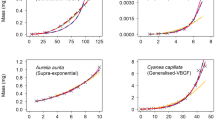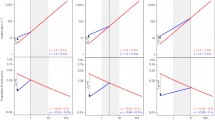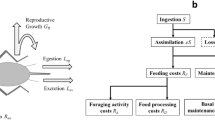Abstract
Modeling the growth of animals as parts of ecosystems often presumes the existence of an asymptotic weight which, when reached by the individual, stops its further growth. We show that the asymptotic weight is influenced by environmental conditions, and that growth is limited because of a trade-off of foraging costs and gain of feeding. We show that the so-called asymptotic mass is a comprehensive value, which also contains an environmental parameter. We develop our model for organisms of neutral buoyancy in an aquatic environment; for terrestrial and aerial animals it has limited validity only. We discuss examples and derive a critical value for resource availability in a habitat, which informs us whether foraging in that habitat is worthwhile or not.
Similar content being viewed by others
References
Bertalanffy, L. v. 1934. Untersuchungen über die Gesetzlichkeit des Wachstums. 1. Teil. Allgemeine Grundlagen der Theorie; mathematische und physiologische Gesetzlichkeiten des Wachstums bei Wassertieren.Arch. Entwicklungsmech. 131, 613–652.
Brett, J. R. 1964. The respiratory metabolism and swimming performance of young sockeye salmon.Journal of the Fisheries Research Board of Canada 21, 1183–1226.
Damuth, J. 1981. Population density and body size in mammals.Nature 290, 699–700.
Elliot, J. M. 1979. Energetics of teleosts. InSymposia of the Zoological Society of London, P. J. Miller (Ed.), Vol. 44. London: Academic Press.
Gabrielli, G. and Th. von Karman. 1950. What price speed?.Mech. Eng. 72, 775–781.
Gill, F. B. 1989.Ornithology, New York: W. H. Freeman.
Greenewalt, C. H. 1975. The flight of birds.Trans. Amer. Philos. Soc. 65, part 4, 1–67.
Hickmann, C. P., L. S. Roberts and A. Larson. 1993.Integrated Principles of Zoology. St. Louis. Mosby.
Jones, D. R. and D. J. Randall. 1978. The respiratory and circulatory systems during exercise.Fish Physiology 7, 425–501.
Jonson, L. 1992.Die Vögel Europas und des Mittelmeerraumes. Stuttgart: Kosmos.
Krebs, J. R., J. T. Erichsen, M. I. Weber, and E. L. Charnov. 1977. Optimal prey selection in the Great Tit (Parus major).Animal Behavior 25, 30–38.
Lasiewski, R. C. and W. R. Dawson. 1976. A re-examination of the relation between standard metabolic rate and body weight in birds.The Condor 69, 13–23.
McMahon, T. A. and J. Tyler Bonner. 1983.On Size and Life. New York: Scientific American Books.
Nachtigall, W. 1985.Warum die Vögel fliegen. Hamburg: Rasch und Roehrig Verlag.
Norberg, U. M. 1990.Vertebrate Flight. Berlin: Springer-Verlag.
Pauly, D. 1986. A simple method for estimating the food consumption of fish populations from growth data and food conversion experiments.US Fish. Bull. 84, 827–842.
Reiss, M. J. 1989.The Allometry of Growth and Reproduction. Cambridge: Cambridge University Press.
Tait, R. V. 1981.Elements of Marine Ecology. London: Butterworths.
Temming, A. 1994. Food conversion efficiency and the von Bertalanffy growth function I: a modification of Pauly's model.Naga, the Iclarm Quarterly 17, 38–39.
Tucker, V. A. 1970. Energetic cost of locomotion in animals.Comp. Biochem. Physiol. 34, 841–846.
Videler, J. J. and B. A. Nolet. 1990. Costs of swimming measured at optimum speed: scale effects, differences between swimming styles, taxonomic groups and submerged and surface swimming.Comp. Biochem. Physiol. 97A, 91–99.
Webb, P. W. 1971. The swimming energetics of trout II. Oxygen consumption and swimming efficiency.J. Exp. Biol. 55, 489.
Weihs, D. 1973. Optimal fish swimming speed.Nature 245, 48–50.
Weihs, D. 1975. An optimum swimming speed of fish based on feeding efficiency.Israel J. Technol. 13, 163–167.
Weihs, D. 1977. Effects of size on sustained swimming speeds of aquatic organisms. InScale Effects in Animal Locomotion. T. J. Pedley (Ed). London: Academic Press.
Weis-Fogh, T. 1952. Weight economy of flying insects. InTransactions of the Ninth International Congress on Entomology Vol. 1, pp. 341–347. Excelsior.
Werner, E. and A. Bradley. 1993. Ecological consequences of the trade-off between growth and mortality rates mediated by foraging activity.The American Naturalist 142, 242–272.
Author information
Authors and Affiliations
Rights and permissions
About this article
Cite this article
Stöcker, S., Weihs, D. Foraging costs as a defining factor for growth and asymptotic mass. Bltn Mathcal Biology 58, 739–751 (1996). https://doi.org/10.1007/BF02459480
Received:
Revised:
Issue Date:
DOI: https://doi.org/10.1007/BF02459480




